The American Institute of Architects (AIA) Committee on Architecture for Education (CAE) has selected 12 projects for this year’s CAE Education Facility Design Awards. The program honors educational facilities that the jury believes should serve as an example of a superb place in which to learn, furthering the client's mission, goals, and educational program while demonstrating excellence in architectural design.
The 12 winners are listed below.
Henderson-Hopkins School; Baltimore
Rogers Partners
Associate Architect: Architects+Urban Designers
Award of Excellence
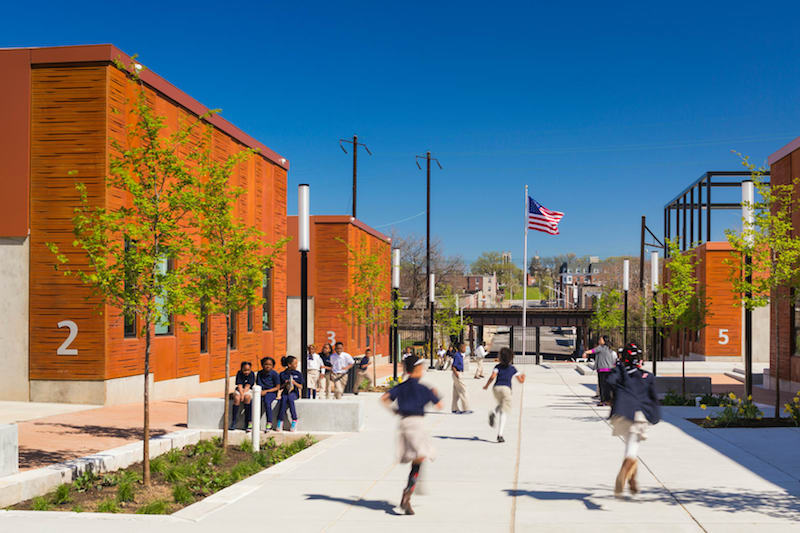
The Henderson-Hopkins School is the first new Baltimore public school in nearly 30 years. A 125,000-square-foot K-8 partnership school and early childhood center run by Johns Hopkins University, Henderson-Hopkins is a progressive learning environment for children and a laboratory for the next generation of educators.
The school is a cluster of “containers for learning” inspired by East Baltimore’s row houses, stoops, and social civic spaces. Through its intentionally porous, safe, urban plan, and the craftsmanship of light, materiality, and performance, its design respects history and supports the future of education and of its neighborhood.
Mundo Verde Bilingual Public Charter School; Washington, DC
Studio Twenty Seven Architecture
Award of Excellence
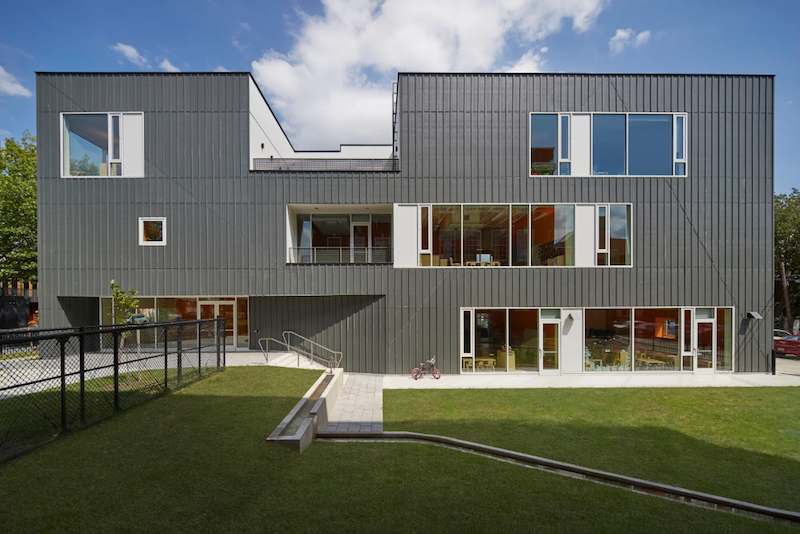
Mundo Verde is a bilingual, sustainability-focused public charter school located in the District of Columbia. The school’s curriculum is based on expeditionary learning, where students learn through the critical exploration of complex issues.
Awarded a shuttered 1920s-era school building and site by the District in 2013, Mundo Verde had a direct question for the design team: “How can this redevelopment and addition project teach our students to be global stewards?” From the renovation of the existing building to the precise detailing and material efficiency of the Pre-K annex, the entire campus is designed to foster learning through environmental living.
Regional Plant 2 Teaching Facility, Wake Technical Community College; Raleigh, N.C.
Clark Nexsen
Award of Excellence
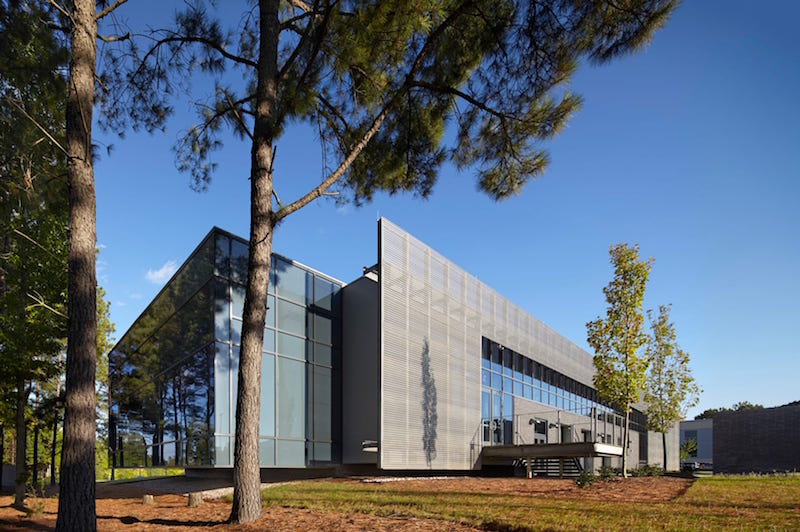
Located at the entrance of Wake Tech Community College on a wooded site, the Regional Plant Teaching Facility creates a gateway to the campus and symbolizes the merging of technology, education and sustainability.
Although the building’s program is composed of spaces to house heating and cooling equipment, it also serves as an educational facility for teaching students and the public about energy-efficient building systems. A simple rectilinear glass and steel box with a perforated metal screen layer houses, screens and displays the technology and creates a unique educational space for the college.
Regional Plant
Richard Ivey Building, Richard Ivey School of Business, Western University; London, Ontario, Canada
Hariri Pontarini Architects
Award of Excellence
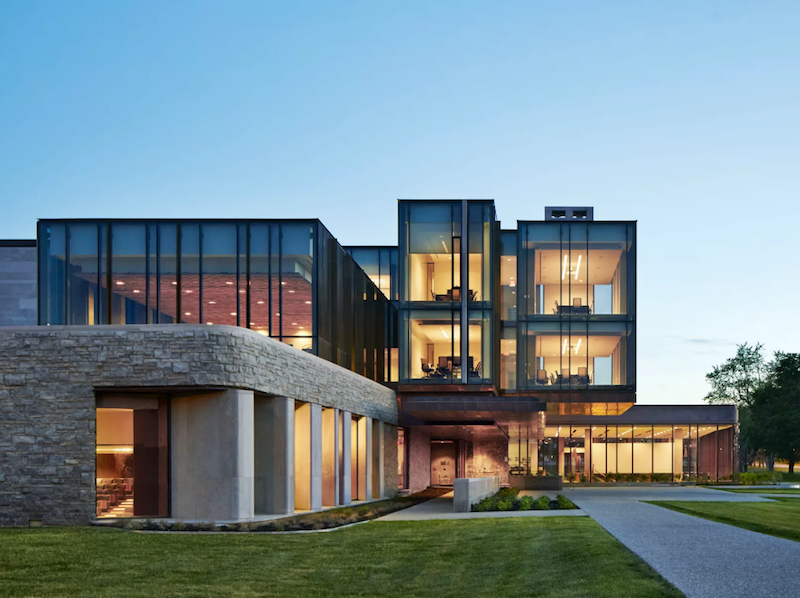
The vision for the Richard Ivey Building was creation of a vibrant, unified campus that would attract the best students and faculty, express the school’s global identity, and celebrate Western University itself.
Located on the western edge of the university’s campus at an active corner, the Richard Ivey Building is a beacon, a signifier of the school’s flagship status. Echoing the architecture of Western University's campus and the adjacent Brescia College, the solid masonry on the exterior conveys the traditional materiality of the University’s Gothic architecture, making it a modern building rooted in tradition.
Seton Hill Arts Center, Seton Hill University; Greensburg, Pa.
designLAB architects
Associate Architect: BSHM Architects
Award of Excellence

Seton Hill University’s new performing and visual arts facility is an interdisciplinary arts center that connects the local community with members of the university. Channeling the Pittsburgh area’s industrial heritage, the steel frame and metal-clad building was conceived as a “Factory for the Arts.” The project features an outdoor Arts Yard where the making of 3D arts is visible from the commercial Main Street in its host city of Greensburg, Pennsylvania.
The four-level facility features a full complement of studio spaces for traditional disciplines like painting, drawing, printmaking, sculpture, dance and theater, along with tech-heavy digital and graphic arts. The new building is an economic catalyst for the city’s cultural district, drawing local artists, gallery observers, and performing arts attendees to support and critique student work.
Vol Walker Hall Renovation & The Steven L. Anderson Design Center, University of Arkansas; Fayetteville, Ark.
Marlon Blackwell Architects
Associate Architect: Polk Stanley Wilcox Architects
Award of Excellence

Vol Walker Hall and the addition of the Steven L. Anderson Design Center for the Fay Jones School of Architecture and Design at the University of Arkansas is a complex but resolute hybrid of a historic restoration and a contemporary insertion and expansion.
Post-tensioned concrete and Indiana limestone honor the weight and substance of the historic, while the west-facing fritted glass brise-soleil and steel curtainwall create a contemporary figure. The overall design is a didactic model, establishing a tangible discourse between past and present, while providing state of the art facilities for 21st century architectural and design education.
Dwight-Englewood School Hajjar STEM Center; Englewood, N.J.
Gensler
Award of Merit
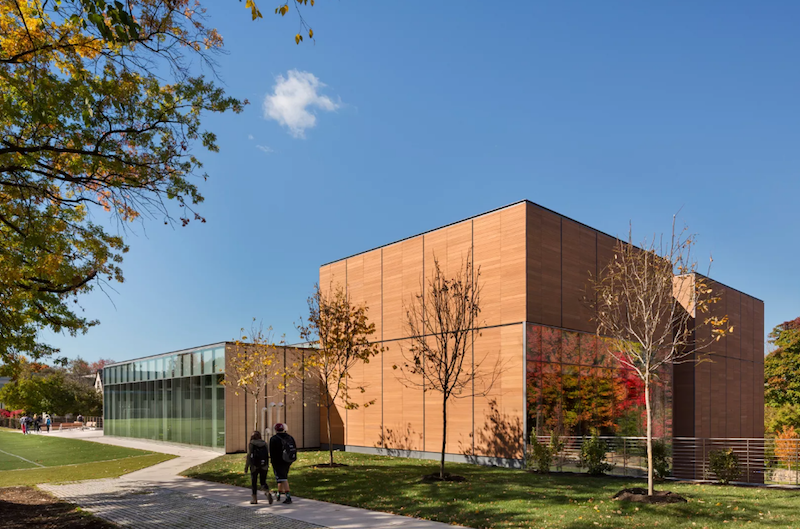
The new 28,000-square-foot building at the Dwight-Englewood School, an independent day school for PK-12, is the realization of a multi-year exploration and visioning process. It is also the embodiment of the school’s mission and growing STEM (science, technology, engineering, math) curriculum.
The technically innovative, highly sustainable, programmatically energized, and contextually sensitive solution equals an expanded campus that seeks to unify Dwight-Englewood's community of faculty, students, and administration and create a center of excellence around this ever-important pedagogy.
Fayetteville High School Addition and Renovation; Fayetteville, Ark.
Hight Jackson Associates
Associate Architect: DLR Group and Marlon Blackwell Architects
Award of Merit
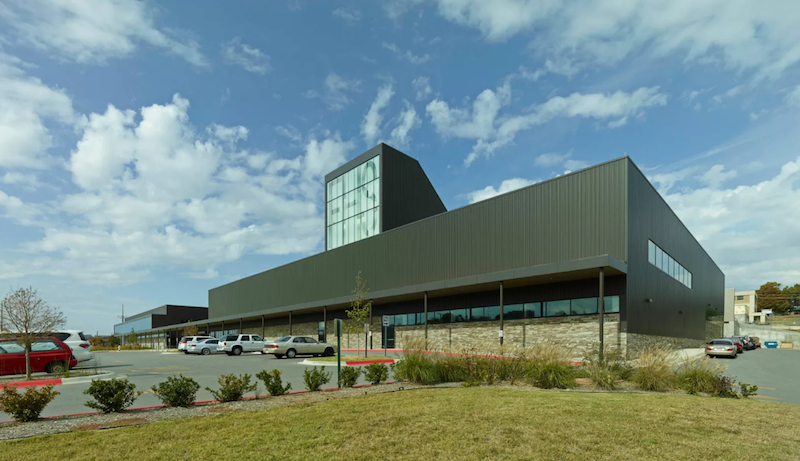
To maintain its competitive advantage in academics, Fayetteville Public Schools tasked the design team to strategically restructure its high school education program into a small learning community (SLC) model. At more than 500,000 square feet, this project is the largest civic project in Fayetteville over the past 50 years. It constitutes an addition and a massive modernization of aged buildings through a 36-month phased approach, allowing for continuous operation of the school during construction.
Fayetteville High School features greatly simplified circulation and improved security around a public entry plaza and a pedestrian green street that mediates between the first and second phase and the 85-foot change in topography across the site. SLCs are designed with core learning studios that feature discovery, project-based learning, digital and applied learning labs to foster collaboration. Distributed administration, resource centers and dining allow students to spend a majority of their day within their SLC. The addition features abundant glass and overlooks a new landscaped street that creates a collegiate campus feel reflective of the school's ties to the University of Arkansas.
GateWay Community College Integrated Education Building; Phoenix
SmithGroupJJR
Award of Merit
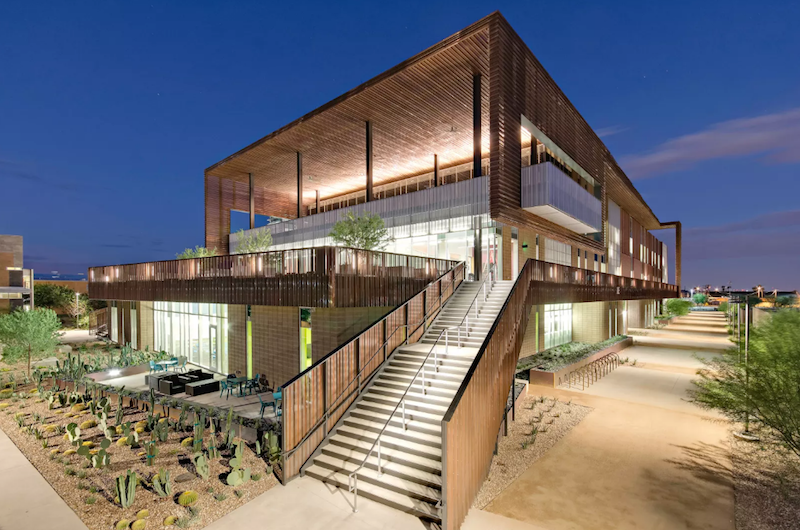
GateWay Community College, located centrally in the metropolitan Phoenix area, has created a new all-in-one 122,000-gross-square-foot facility for their urban campus. The Integrated Education Building (IEB) is centrally located on campus and meshes an entire new campus of functions into a single three-story structure.
The IEB provides a new student services center, learning center and community library, instructional labs, classrooms, faculty offices and a large community-oriented 200-seat multi-purpose room. The project both transforms the campus and provides metamorphic momentum for a historically blighted and under-valued part of the city.
Harvard Business School, Tata Hall; Boston
William Rawn Associates, Architects, Inc.
Award of Merit

Sited on the banks of the Charles River, Tata Hall at Harvard Business School creates a porous edge to the campus and a new sense of openness between the school and the city of Boston. Dedicated to the Executive Education program, the building groups students into clusters of eight-person suites, each with a common space for work, collaboration and presentations.
Indian Springs School; Birmingham, Ala.
Lake|Flato Architects
Associate Architect: Architecture Works
Award of Merit
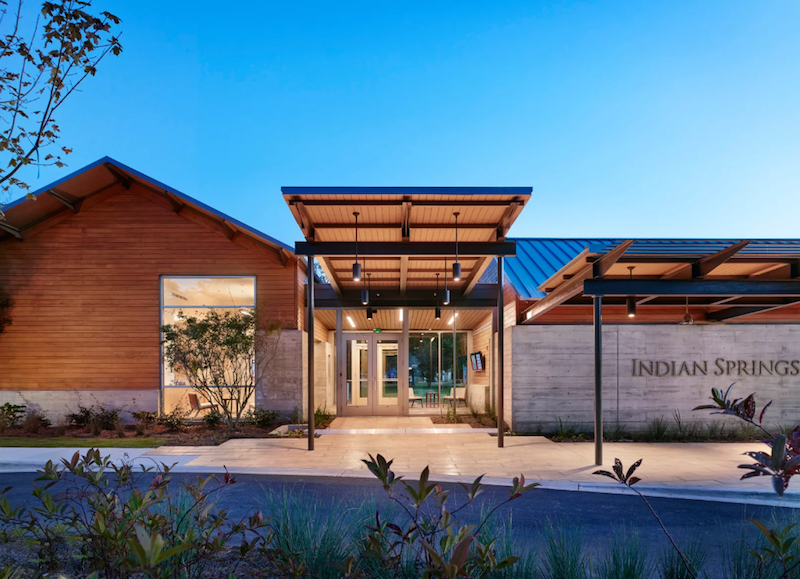
Founded in 1952 on the motto, “Learning Through Living,” Indian Springs School is a place of exceptional people and purpose. The 350-acre boarding and day school campus, originally planned by the Olmstead Brothers, was functional and serviceable but aging facilities were inhibiting the growth of educational programs and opportunities.
This first phase of a comprehensive master plan includes new academic and administrative buildings and complementary landscapes that create a memorable, meaningful place. The new academic heart of the campus recalls its original vision with a contemporary overlay of teaching methodology, technology, aesthetics and performance that make a unique learning environment—Springsian in every way.
Kennedy Child Study Center; East Harlem, N.Y.
Pell Overton Architects
Award of Merit
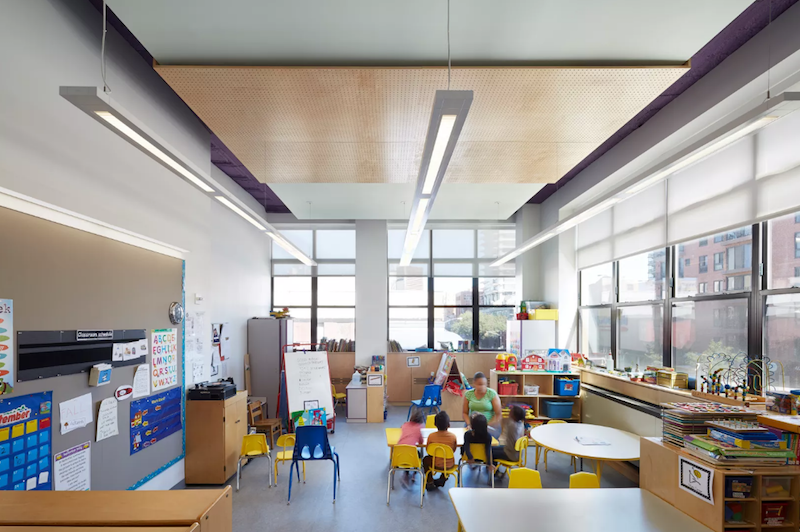
Last summer, the 165-family Kennedy Child Study Center relocated to a new home in East Harlem, occupying two floors of a previously un-renovated 1930’s warehouse building. The adaptive reuse of the 25,000-square-foot space presented a number of difficult challenges, including an unusually low ceiling and absence of any natural light.
Consequently, the design of the 16-classroom facility developed around the need to radically transform the existing warehouse into a varied space for learning and engagement, creating a sense of both openness to the surrounding community and continuity between the neighborhood and the individual classroom environments.
The jury for the 2016 Educational Facility Design Awards includes: Karina Ruiz, AIA (Chair), DOWA-IBI Group Architects; Christina Alvarez, Delaware Design Lab HS; Helena L. Jubany, FAIA, NAC/Architecture; Bruce Lindsey, AIA, Washington University in St. Louis; Zachary Neubauer, University of Portland and Steve Ziger, AIA, Ziger/Snead Architects.
See the full release here.
Related Stories
University Buildings | Oct 15, 2024
Recreation and wellness are bedfellows in new campus student centers
Student demands for amenities and services that address their emotional and mental wellbeing are impacting new development on college campuses that has led to recreation centers with wellness portfolios.
University Buildings | Oct 9, 2024
Des Moines University Medicine and Health Sciences opens a new 88-acre campus
Des Moines University Medicine and Health Sciences has opened a new campus spanning 88 acres, over three times larger than its previous location. Designed by RDG Planning & Design and built by Turner Construction, the $260 million campus features technology-rich, flexible educational spaces that promote innovative teaching methods, expand research activity, and enhance clinical services. The campus includes four buildings connected with elevated pathways and totaling 382,000 sf.
University Buildings | Oct 4, 2024
Renovations are raising higher education campuses to modern standards
AEC higher ed Giants report working on a variety of building types, from performing arts centers and libraries to business schools. Hybrid learning is seemingly here to stay. And where possible, these projects address wellness and mental health concerns.
Museums | Oct 1, 2024
UT Dallas opens Morphosis-designed Crow Museum of Asian Art
In Richardson, Tex., the University of Texas at Dallas has opened a second location for the Crow Museum of Asian Art—the first of multiple buildings that will be part of a 12-acre cultural district. When completed, the arts and performance complex, called the Edith and Peter O’Donnell Jr. Athenaeum, will include two museums, a performance hall and music building, a grand plaza, and a dedicated parking structure on the Richardson campus.
Education Facilities | Sep 16, 2024
Hot classrooms, playgrounds spur K-12 school districts to go beyond AC for cooling
With hotter weather occurring during the school year, school districts are turning to cooling strategies to complement air conditioning. Reflective playgrounds and roads, cool roofs and window films, shade structures and conversion of asphalt surfaces to a natural state are all being tried in various regions of the country.
University Buildings | Sep 4, 2024
UC San Diego’s new Multidisciplinary Life Sciences Building will support research and teaching in both health and biological sciences
The University of California San Diego has approved plans for a new Multidisciplinary Life Sciences Building, with construction starting this fall. The 200,000-sf, six-level facility will be the first building on the UC San Diego campus to bridge health science research with biological science research and teaching.
K-12 Schools | Aug 29, 2024
Designing for dyslexia: How architecture can address neurodiversity in K-12 schools
Architects play a critical role in designing school environments that support students with learning differences, particularly dyslexia, by enhancing social and emotional competence and physical comfort. Effective design principles not only benefit students with dyslexia but also improve the learning experience for all students and faculty. This article explores how key design strategies at the campus, classroom, and individual levels can foster confidence, comfort, and resilience, thereby optimizing educational outcomes for students with dyslexia and other learning differences.
Curtain Wall | Aug 15, 2024
7 steps to investigating curtain wall leaks
It is common for significant curtain wall leakage to involve multiple variables. Therefore, a comprehensive multi-faceted investigation is required to determine the origin of leakage, according to building enclosure consultants Richard Aeck and John A. Rudisill with Rimkus.
K-12 Schools | Aug 8, 2024
New K-12 STEM center hosts robotics learning, competitions in Houston suburb
A new K-12 STEM Center in a Houston suburb is the venue for robotics learning and competitions along with education about other STEM subjects. An unused storage building was transformed into a lively space for students to immerse themselves in STEM subjects. Located in Texas City, the ISD Marathon STEM and Robotics Center is the first of its kind in the district.
Education Facilities | Aug 4, 2024
A former supersonic wind tunnel becomes a new educational facility for transportation design
The Mullin Transportation Design Center at ArtCenter College of Design in Pasadena, Calif., provides access for full-scale vehicular models, replicating a professional design studio.

















